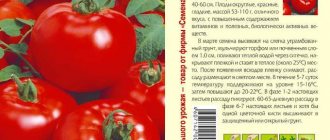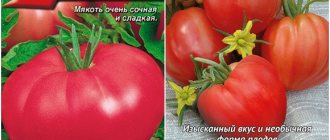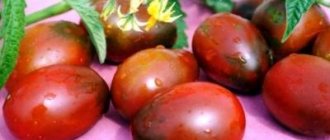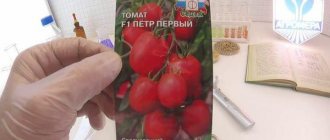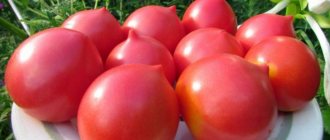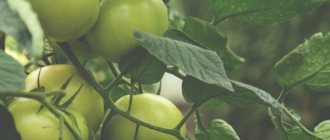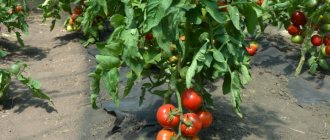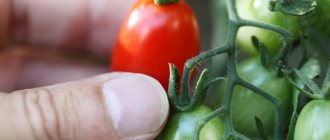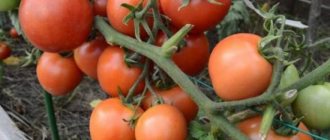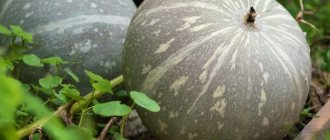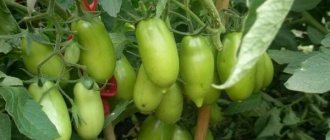The gardener’s dream is to grow a variety of tomatoes that would have excellent taste, decent presentation and would be undemanding in care. The tomato variety Andreevsky Surprise meets all these requirements.
| Height | Landing location | Ripening time | Fruit color | Fruit size | Origin | Fruit shape |
| Tall | Greenhouse, Open ground | Late ripening | Pink | Large | Variety | Flat-round |
Description of the variety
The late-ripening tomato variety Andreevsky Surprise was bred by Siberian breeders. This means that it is also cultivated in regions with cool climates. In 2007, the tomato was included in the state register of the Russian Federation. The vegetable is grown both in greenhouses and in open ground. In the southern regions of Russia, tomatoes bear fruit well in open beds; in other regions, St. Andrew's surprise is cultivated in greenhouse conditions.
The variety belongs to the indeterminate type of plants, that is, it is unlimited in growth. The bushes grow up to 2 m in height. The leaves are medium sized and dark green in color. Every 3 leaves the culture forms inflorescences. The plant is self-pollinating, but cross-pollination of flowers by insects or wind is also possible. After the formation of 8-9 sheets, the first brush appears. Fruit ripening occurs gradually, starting from the lower clusters. The peduncle has an articulation. The variety needs pinching and tying to a trellis or stake.
Distinctive features
The tomato variety Andreevsky Surprise is not characterized by high yield, but has large fruit sizes, while the quality of the tomatoes remains high. Vegetables ripen well on their own in a dark and warm place.
Fruit characteristics and yield
The fruits have excellent taste. Tomato Andreevsky surprise has the following characteristics:
- fruits are round-flat, smooth, of medium density;
- the color of the skin and pulp of ripe tomatoes is deep pink;
- the pulp is juicy and dense, multi-chambered;
- the weight of one fruit reaches from 300 to 500 g, but sometimes tomatoes grow up to 1 kg;
- tomatoes are tasty, sweet;
- The vegetable is universal in use.
From 1 sq. m harvest from 4 to 8 kg of crop. When growing tomatoes in a greenhouse under all agrotechnical conditions, the yield reaches a maximum. When cultivating tomatoes in open ground, fruiting rates are reduced due to the unstable climate. The tomatoes ripen together. Fruiting occurs in the second half of July. The last harvest of tomatoes is carried out in the third ten days of August.
Did you know? Tomatoes were known to Europeans already from the mid-16th century, but they began to be eaten only at the end of the 18th century. Before this, tomato bushes were grown exclusively as ornamental plants, and their fruits were considered poisonous. As early as 1774, gardening manuals warned that tomatoes would drive those who ate them crazy. Perhaps they were not so far from the truth: a delicious juicy tomato, if it does not drive a true gourmet crazy, will certainly delight!
Tomato hybrid Indoor surprise - brief description
The complete opposite of the variety described above is the hybrid variety Room Surprise (second name Balcony Surprise). This is a low-growing tomato intended for home growing (read more about indoor tomatoes here). This hybrid is also often used for rack (tiered) cultivation in greenhouses - on the top shelves. Its fruits are very tasty and beautiful, and are in high demand in markets and for restaurant cuisine.
- The bush is low-growing, no more than 50 cm in height.
- The stem is strong and can be grown without support - then it lies on the ground or hangs from a flowerpot. But still, it is better to make the simplest support for the plant - a bush hung with bright tassels, very decorative.
- Vegetable growers claim that the hybrid behaves like a perennial plant - after replanting, radical pruning and renewal, it again begins to grow and yield.
- There is no point in collecting seeds, varietal characteristics are not preserved, but the hybrid is easily propagated by cuttings - the shoots are rooted in water and planted as seedlings.
- The hybrid almost never gets sick! Resistant to all types of nightshade diseases.
- The variety is self-pollinating and does not require insects, which is convenient for the home. There are 6-8-10 ovaries in the cluster, maturation begins from the stem.
Room surprise tomato tomatoes, according to photos and reviews, are very attractive, bright red, oval in shape, even in size, very tasty, sweet with a slight sourness, weight 50 g, dense flesh. Used in salads and for drying, for preparations in general.
Caring for the Indoor Surprise tomato is the same as for other potted varieties: you can sow directly into flowerpots, the volume is at least 5 liters, no shaping or pinching is required. But if you leave 3-4 stems, the tomatoes will be larger.
Marianna Pavley
How to grow seedlings
The most reliable method of cultivating tomato crops is seedlings. Vegetable growers sow seeds in early to mid-March. They focus on the time when, when planting tomatoes in a permanent place, night frosts will pass irrevocably. Seedlings are grown for about two months.
Seed preparation
Seeds purchased from a specialized gardening store do not require processing. Disinfection is carried out by the manufacturer, which is indicated on the packaging of grains. If the seed material was purchased secondhand or collected from your own harvest, the grains are disinfected. To do this, keep the seeds for 20-30 minutes in a 1% solution of potassium permanganate.
Container and soil
The following containers are used for growing seedlings:
- polypropylene or plastic cups;
- plastic or wooden boxes of any size;
- special purchased containers with cells;
- peat cups or tablets.
They also use containers from improvised materials, for example, cut-off bottles or milk cartons. The best option is peat tablets or cups, as they contain a very nutritious soil mixture. Another advantage of such products is convenient transplantation. When diving, it is enough to simply move the tablet into a large container. Over time, the peat walls become limp and dissolve in the soil. In this case, the root system is not damaged, and the plant itself does not experience stress when conditions change.
Use purchased soil or prepare it yourself by mixing manure, neutral peat, sand and soil from the garden in a ratio of 1:1:1:3.
The soil must be disinfected with a strong solution of potassium permanganate. Soil disinfection is carried out 1-2 days before sowing. After the procedure, bacteria useful for the growth of the culture begin to develop in the soil.
Sowing
Planting seeds for seedlings is done as follows:
- a drainage layer (small pebbles or river sand) is poured onto the bottom of the container;
- the prepared soil mixture is placed in the container;
- several parallel grooves 2 cm deep are made on the soil surface, and the distance between them is 3-4 cm;
- the seeds are planted in grooves at a distance of 2-3 cm from each other.
The container is covered with transparent glass or polyethylene. This creates a suitable microclimate for the seeds. The container is ventilated once a day.
Growing and care
After 3-4 days at a temperature of +25 °C, the first tomato sprouts appear. The crop does well without additional lighting, so the container with seedlings is simply placed on the windowsill.
For your information. After removing the film, the soil dries out much faster, therefore, tomato seedlings are moistened as the soil dries out and the optimal temperature regime is maintained (+25°C).
At the time when the seedlings have 2 true leaves, the plants are planted into separate containers. In order not to delay the further development of tomatoes, experienced vegetable growers do the following:
- when transplanting, the plants are buried almost to the cotyledon leaves, so the bushes will begin to form new roots;
- to protect plants from fungal diseases, the roots of seedlings are disinfected in a 1% solution of potassium permanganate;
- 10 days after transplantation, the plants are given the first fertilizing.
Further fertilizers are carried out at intervals of every 7-10 days. Mullein infusion is used as a top dressing. Tomato seedlings are also hardened off. Two weeks before the intended planting, the plants are taken out onto the street or balcony for 1-2 hours. The time spent by tomatoes in the fresh air is gradually increased.
Preparing and planting seeds
To achieve not only high yields from tomatoes, but also excellent taste, you need not only special preparation, but also further compliance with the optimal microclimate for young shoots. Without this, crops will suffer from low immunity, which almost always threatens their death.
Seed preparation begins with their sterilization. This measure is mandatory, since only through sterilization can pathogens of various fungal infections be eliminated from the surface of seeds. To do this, the seed material is soaked in special bactericidal solutions; most often, 2% potassium permanganate or 70% alcohol solution is used for these purposes. In the first case, the seeds are soaked for 20 minutes, when using alcohol - no more than 10 minutes.
To improve the quality of seedlings, immediately before sowing, the seeds must be soaked in growth stimulants for 6–8 hours. Most often, solutions of “Sodium Humate”, “Kornevin” or “Zircon” are used for this. You can replace chemicals with aloe juice. To do this, it is mixed with clean water at room temperature (1:1), while soaking in an organic solution is extended to 24 hours.
Sowing seedlings
- With the row method, rows are created over the entire surface of the container with a row spacing of 3-4 cm. Sowing is carried out so that in the future there is a free space of at least 1-2 cm between the seeds.
- With the hole method, holes are made in the soil at a distance of 3-4 cm, 2-3 seeds are placed in each of them, of which over time only one sprout is left.
Regardless of the type of sowing, the seed depth should be within 1-2 cm.
Growing seedlings
The seeded containers are well moistened and then covered with a dome made of transparent polyethylene or glass. After this, they are transferred to a well-lit place with a temperature of about 25°C. A southern or southwestern window sill is best suited for this, as the most intense lighting is observed here.
After removing the dome, tomatoes are grown at a temperature of 18... 20°C during the day and about 15°C at night. Before transplanting to a permanent location, the plants are provided with 10–15 hours of daylight; for this, the flowerpots should be illuminated with a garden or table lamp. The first week after removing the protective dome, the seedlings are watered once a week; in the phase of 2-3 leaves, watering is carried out every 4 days. Water is added to the pots in small portions, while sudden changes in soil humidity, which are always fraught with oppression for plants, are prohibited.
Did you know? The leading country in growing tomatoes is China. Every year, Chinese farmers manage to produce more than 50 million tons of fruit, which is a third of the world production of this vegetable.
Seedlings are planted in rows or pits, to a depth of 25–30 cm. The traditional planting pattern is 60×60 cm, but when planting in rows, you can adhere to the 70×40 cm pattern. Thus, about 6–8 tomatoes should be placed per 1 m² of plantings .
In a permanent place - in a greenhouse or just in a garden bed - these tomatoes are usually placed according to a 50x40 cm pattern. At the same time, they ensure that there are 3-4 bushes per 1 m2. The roots of St. Andrew's surprise seedlings usually reach a considerable length. Experienced summer residents therefore advise preparing holes 30-40 cm deep for them in advance - in the fall.
At the bottom of such holes, a little earth mixed with organic matter is usually poured. Then the tomato is placed in the hole and rolled over with fertilized soil and a tamper.
How to grow tomatoes
Proper cultivation of Andreevsky Surprise tomatoes consists of timely moistening, loosening the soil and periodically weeding the beds from weeds. Although the crop has good disease resistance, gardeners still treat the soil with a weak solution of potassium permanganate.
Landing
If flower clusters begin to appear on the seedlings, it means that it is time to transplant the plants into open ground or into a greenhouse no later than two weeks later. Violation of these deadlines will lead to a slowdown in crop growth, which will result in a subsequent reduction in yield.
If it is not possible to transplant the tomatoes during this period, the flower cluster that appears is pinched off. So the planting dates are postponed for another week. Tomatoes planted on time will produce their first harvest within two months after transplanting to a permanent location.
Since the plants are tall, the height of the greenhouse must correspond to the height of the tomatoes (at least 2 m). The soil is warmed up well before planting tomatoes. Manure is spread evenly on it, which is covered with 15 cm of soil. A small layer of wood ash is placed between the manure and the soil.
Tomatoes are planted in open ground or in a greenhouse according to the following rules:
- leave 60 cm between plants, and 40 between rows;
- If possible, tomatoes are transplanted in cloudy weather, in the late afternoon;
- install a trellis or pegs in advance so that tall stems are more stable and do not break from strong winds.
Care
The Andreevsky Surprise variety is cared for in the standard way, like all tomatoes. To ripen the fruits, tomatoes are regularly moistened and fertilized.
Plant care:
- Water the tomatoes at the root (10 liters per bush once a week).
- Feed the crop every 3 weeks. Mineral fertilizers are alternated with organic ones, and for faster fruit ripening, potash fertilizers are applied.
- The soil around the bushes is loosened and weeds are removed at the same time.
Since the Andreevsky Surprise tomato variety is indeterminate, the bushes must be formed correctly. All stepsons are removed from the plant, and then it is brought into 1-2 stems.
Features of cultivation and possible difficulties
Both in open ground and in a greenhouse, tomatoes are tied to a trellis, but not too tightly. Otherwise, the plant will die. If the crop grows in a greenhouse, it must be ventilated by opening two opposite windows or doors.
Diseases and pests
Although the Andreevsky Surprise tomato variety has strong immunity, under unfavorable conditions or improper care there is a risk of plant disease. Therefore, prevention is needed.
Mosaic is a viral disease that manifests itself as yellow spots on the leaves and their subsequent deformation. For sowing tomatoes, whenever possible, use seeds that are 3-4 years old. Before planting, the grains are disinfected for 20-30 minutes in a 1% solution of potassium permanganate. Every 10 days, seedlings are treated with skim milk (1 liter of milk and 1 teaspoon of urea are dissolved in 10 liters of water). Sick plants are removed.
Late blight is a fungal disease. It covers the leaves with brown spots, which gradually spread to the fruits. To prevent and treat the disease, plants are sprayed with iodine solution (1 teaspoon per 10 liters of water) or calcium nitrate solution (1 tablespoon per 10 liters of water). The drug "Profit Gold" is also used.
Growing rules
When growing tomatoes, including the Andreevsky Surprise variety, you should follow some rules:
- Grow in a sunny place.
- Provide sufficient moisture.
- The vegetable must ripen on the bush.
- Proper feeding is required.
And also do not neglect loosening, weeding, and mulching.
Planting seedlings
The conditions for growing tomatoes in seedlings are traditional. But the Andreevsky Surprise variety has a distinctive feature - the seedlings do not require additional lighting.
It is enough to pour a 6-8 cm layer of soil into the seedling boxes. Distribute the tomato seeds according to the pattern: 2 cm between tomatoes in a row and 4 cm between rows of tomatoes.
Seedlings will develop well at a temperature of + 25-28 ° C.
At temperatures below + 18 °C, the growth of seedlings stops. This fact can be used if the seedlings are overgrown. To maintain a high temperature, seedling containers are covered with film.
The crops are ventilated daily by lifting the film. Water with a spray bottle, avoiding over-watering. The first tomato seedlings will sprout in 4-6 days.
A few tips will help you avoid errors when growing:
- Picking seedlings when 2 true leaves appear. The sooner the plants are transplanted, the faster they adapt to new conditions and strengthen the root system. This procedure should be performed up to 3 times during the growing of seedlings. Since the variety is indeterminate, picking is aimed at restraining plant growth without shifting the start of fruiting.
- Deepening tomato seedlings St. Andrew's Surprise to the cotyledon leaves to form additional roots.
- Carrying out the first fertilizing of tomato bushes a week after picking. Fertilizers are used no more than 2 times during the entire period.
- Don't forget about hardening off the seedlings. A month before planting in the ground, the seedlings are taken out into the fresh air, gradually increasing the time spent outside.
The seedlings are transferred to the greenhouse in early May. The transplantation of seedlings into open ground will occur later, after the average daily temperature has reached at least + 15 °C. The date for planting tomatoes depends on the specific region.
Tomato transplant
Seedlings that are going to be transplanted into open ground or a greenhouse have certain requirements. Tomato seedlings St. Andrew's Surprise, judging by the reviews of gardeners, should have a thick stem, large dark green leaves and a powerful root system.
At the time of transplantation, the seedlings should have one flower cluster, but with unopened buds. If the flowers have already bloomed, vegetable growers recommend removing them. But there is no point in removing the first flower of this variety - this does not increase the yield, and the largest fruit will be lost.
The optimal age of seedlings for planting is 60-65 days. Tomatoes are planted at the rate of 2 plants per 1 sq. m or according to the 50x50 cm pattern.
A description of transplanting the tomato variety Andreevsky Surprise will be incomplete without highlighting several important points:
- Tomato stems are tied immediately upon planting to supports in the form of stakes or trellises.
- Self-grown seedlings can be planted in a permanent place at any time of the day, while purchased seedlings can be planted in cloudy weather or in the evening.
- It is advisable to bury the stems of tomatoes not reaching the first true leaves of 2-3 cm. Overgrown seedlings are placed in furrows, leaving a seedling of normal height above the soil surface.
Subsequent care for tomatoes
To ensure that the work on growing seedlings is not wasted, it is necessary to create favorable conditions for the formation of high-quality fruits, namely:
- systematic watering;
- fertilizing;
- removal of stepsons;
- tying to supports as you grow;
- formation of tomato bushes into 1-2 stems.
Water the tomatoes with settled water 2 times a week, in the morning or evening. The bushes are watered abundantly.
During the season, fertilizing is required three times. The first fertilizing is aimed at enriching the soil with organic and nitrogen fertilizers. During the period of the appearance of ovaries, potassium fertilizers are necessary. When fruits are forming, tomatoes are fed with complex phosphorus-potassium compounds.
Removing side shoots (side shoots) that appear in the leaf axils increases the supply of nutrients to tomatoes. The pinching technique is used to accelerate the ripening of fruits. Tomato shoots must be removed until they exceed 5 cm by pinching or breaking off by hand.
The greenhouse is regularly ventilated and the temperature is maintained no higher than + 30 °C.
In order for the set fruits to have time to ripen, the tops of the shoots must be pinched in early August in the northern regions and at the end of August in the south.
The nuances of growing in open ground and in a greenhouse
Plants bear fruit on almost any soil, but crop rotation plays an important role. Good predecessors for tomatoes:
- beet;
- cucumber;
- turnip;
- zucchini;
- pumpkin;
- green onions;
- squash;
- beans.
The crop is not grown after tomatoes, potatoes and other nightshades earlier than 3-4 years. Otherwise, the soil becomes a potential carrier of various infections and pest larvae.
Important! Before planting tomatoes, the soil is fertilized with green manure. To do this, in the fall, the area is sown with leguminous grasses (sainfoin, alfalfa, clover, etc.), which are mowed and plowed into the soil 5-8 cm 2 weeks before planting.
How to choose a place on the site
St. Andrew's surprise, as already mentioned, is not particularly demanding of the sun. But, of course, it’s still not worth planting it in the shade on the site. The beds for this tomato should be set up away from fruit or ornamental trees, fences, walls of outbuildings, etc.
Since these tomatoes have a significant height and also usually grow quite thick, they need to be planted in a well-ventilated area. But, of course, there should not be too strong winds in the place where tomatoes of this variety are grown.
Advantages and disadvantages of the variety
Positive aspects of the Andreevsky Surprise tomato variety:
- undemanding to growing conditions;
- excellent taste of the fruit;
- good disease resistance;
- the possibility of growing crops in the northern regions;
- independent ripening of fruits picked from the bush;
- large size vegetables;
- high sugar content.
Disadvantages of the variety:
- low yield;
- cracking of fruits due to excessive moisture;
- short shelf life (no more than 2 weeks);
- the need for pinching (shoots are formed throughout the season);
- poor transportability.
A selection of reviews from amateur gardeners
- Gennady Korotkov in his garden in Astrakhan managed to obtain fruits weighing up to 900 g. The gardener notes the increased resistance of tomatoes to diseases.
- Not everything went smoothly with the cultivation of these tomatoes for a gardener from the Moscow region (nickname A.I., review on one of the thematic forums). The tomatoes turned out pale and tasteless, but the gardener attributes this feature to the lack of sun on the site.
- Lyobov from Novosibirsk describes the experience of planting varietal tomato seeds from a specific manufacturer - Agros. The woman received full germination even taking into account the overdue date for the sale of the material. I planted the seeds in March and moved the sprouts to the greenhouse in mid-May. She rated the tomato yield as average, but the size, taste and immunity as excellent.
St. Andrew's surprise has more positive reviews. Tomatoes perform well in the greenhouse. They are adapted in many regions of the Russian Federation.
Farmer reviews
The Andreevsky Surprise tomato variety, according to reviews from vegetable growers, is successfully used both for processing and for preparing salads. Let's find out some opinions of summer residents.
Sergey, Izhevsk: “A couple of years ago I saw large tomatoes in a neighbor’s garden. I consulted with him and purchased tomato seeds Andreevsky Surprise. I grew the plant in seedlings, then transplanted it into open ground. The bushes grew powerful and tall; there were not many fruits on them, but they were very tasty. The largest vegetables grew on the lower branches. I haven’t decided yet whether to plant this variety next season or not.”
Tamara, Rostov-on-Don: “I’ve been growing tomatoes for 10 years in a row, this is my favorite vegetable in the garden. I always plant several varieties at the same time. During this time, I collected several decent types of tomatoes. One of them is St. Andrew's surprise. The fruits grow very large, as in the photo of the package with seeds, and at the same time do not lose their taste. I make salads from these magnificent vegetables and process them to preserve juice for the winter.”
Description of tomatoes Andreevsky surprise and subtleties of growing
The initial task of Siberian breeders was to develop a large-fruited variety for greenhouse cultivation in the North. This problem has been solved, plus it turned out that tomatoes of the Andreevsky Surprise variety grow well in open ground. Despite the late ripening period, when grown through seedlings, the bush manages to produce the bulk of the harvest before early frosts, and the remaining fruits ripen well in the cellar.
Main characteristics of the bush
- The tomato bush Andreevsky Surprise belongs to the indeterminate type, height is 1.6-1.8 m, with good nutrition and in greenhouses it reaches 2 m.
- The plant is powerful, well leafy, requires strong support and the formation of 1-2 stems. Stem staking is necessary immediately after planting in the ground.
- It belongs to late-ripening varieties - 120 days pass from the day of sowing to the ripeness of the first cluster.
- A big plus is that the conditions for growing tomatoes do not play a big role. Tomato seedlings St. Andrew's Surprise are not demanding on the level of lighting, tolerate a lack of light well, do not stretch out and do not turn yellow.
- The planting rate depends on the formation of the bush: 1 stem - 4 plants per 1 sq.m., 2 stems - 2-3 plants. In the absence of pinching, the yield drops.
It cannot be said that the variety is characterized by high yield - about 2-3 kg per bush or 8 kg per square meter, and with very good care you can get up to 5 kg per plant. Many gardeners who grew Andreevsky Surprise attribute the low yield to the disadvantages of this variety.
Description of tomato fruit
- The tomatoes are large - the so-called beef tomatoes, flat-round in shape, with slight ribbing, without a green spot at the stalk. The average weight is 400-800 g. The fruits in the first and second cluster are the largest 600-800 g. The next ones become smaller - 300-600 g. There are 3-4 in the cluster. less than 5 tomatoes.
- The color of tomatoes when ripe is red-crimson, rich. Unripe fruits are light green and go through the whitening stage.
- The fruit is multi-chambered, there are few seeds, the pulp is fleshy, juicy, the taste is very pleasant, sweet and sour, rating 4.9 points on a 5-point scale.
- Tomatoes are used fresh, for making juices, ketchup, pasta, and assorted preparations. Due to their large size, they are not suitable for whole canning.
Advantages of the variety
- Undemanding conditions for growing seedlings.
- Excellent taste and quality of fruits.
- Resistant to most tomato diseases, including late blight.
- Possibility of harvesting in open ground in the northern regions.
- Gradual ripening of fruits harvested in autumn.
Minuses
- Low yield.
- The need for constant pinching - shoots are formed throughout the season.
- Cracking of tomatoes due to excess moisture.
- Poor transportability of ripe tomatoes - dents form.
- Short shelf life - no more than 2 weeks.
Features of cultivation
- Seeds for seedlings should be sown in early March for planting in greenhouses in early May, and at the end of March for planting in beds.
- The sprouts must be picked, otherwise the plants will grow vigorously and can rise up to 0.5 m before planting. Picking restrains growth, without shifting the timing of the start of fruiting. Containers for transplantation should be quite large - 0.5 at least, since the root system of the variety is very powerful.
- Caring for tomato seedlings is standard; the sprouts do not require additional lighting, but when the temperature drops below +18 degrees, growth stops. This quality can be used if the seedlings become overgrown.
- During the seedling period, 2 feedings are required - preference should be given to ready-made liquid fertilizers.
- Planting bushes in greenhouses or open ground is done after the soil has warmed up by 12-15 degrees, a maximum of 10 days after the appearance of the first flower cluster; the optimal age of seedlings is 60-65 days. As reviews from amateur vegetable growers say, there is no point in removing the first “royal” flower of this variety - this does not increase the yield in any way, and the largest fruit will be lost.
- It is advisable to make a large hole and fill it well with humus, add a jar of ash and a handful of onion peels (this will repel underground pests).
- Surface fertilizers are applied no earlier than 2 weeks after planting. It is optimal to alternate infusion of manure, weed and nitroammophoska solution. From mid-July, nitrogen preparations should be excluded and fed only with ash and potassium salt.
- To give the harvest a chance to ripen, in the first ten days of August in the northern regions, and at the end in the south, the tops of the shoots must be pinched.
This is interesting: Tomato Alyosha Popovich - we explain in detail
Fruit characteristics and yield
The yield of the hybrid is quite high; subject to optimal growing conditions, up to 8 kg of tomatoes can be harvested from 1 m² of plantings. The plant is late-ripening, so the technical maturity of the fruit occurs no earlier than 125–130 days after the appearance of the first shoots.
Did you know? After entering Europe,
the tomato was for a long time considered an ornamental and even poisonous species, since in temperate climates, plant growers were unable to obtain fruit ovaries for a long time. The main distinctive characteristics of the Andreevsky Surprise tomato fruit:
- the average weight of one tomato is in the range of 300–600 g, the maximum can reach up to 800 g;
- the shape of the tomatoes is round, they are slightly flattened in a horizontal position, and also have vertical ribs starting at the tail and ending at the bottom;
- in the technical ripeness phase, the fruits have a rich pink color, turning into crimson tones;
- the pulp has a delicate tomato aroma and a moderate sweetish taste.
Harvest and storage
The first harvest of the Andreevsky Surprise variety is harvested in mid-September. The fruits ripen quite quickly, so they are removed from the plant every 2-3 days. Mass harvesting is carried out after the night temperature drops to +13°C, otherwise the tomatoes will lose their elasticity and keeping quality.
Tomatoes are harvested manually, using a sharp knife or pruning shears, which is used to separate the stalk from the main stem. If the harvested crop has not had time to ripen, it is placed in a warm and well-lit place, at a temperature of +20...+25°C. Depending on the stage of ripeness, the fruits are kept in such conditions for 5 to 10 days, after which they become completely edible.
The collected fruits are placed in cardboard or plastic boxes in several layers, and then moved to a cold and dry place with a temperature of 0 ... + 10 ° C; in such conditions, the crop can maintain its freshness for several weeks. A special vegetable storage facility is best suited for these purposes, but you can also store the harvest in the refrigerator.
Andreevsky Surprise is a high-yielding modern hybrid that can please the gardener not only with large fruits, but also with the excellent taste quality of the harvest. The variety is considered unpretentious, but for successful cultivation, tomatoes need timely and painstaking care. This includes preventive treatments against infections and pests, without which the efficiency of crop cultivation will be reduced significantly.
Prevention of diseases and pests
Prevention of the development of all kinds of diseases and dangerous pests of tomatoes on the site should begin in the fall. In October, before the first frost, the future area for tomatoes must be carefully dug to a depth of at least 25 cm (before sowing green manure). This will allow the soil to freeze well, which will destroy most dangerous insects. For the same purpose, it is necessary to collect all remains of other cultivated plants from the site and dispose of them.
Immediately before planting seedlings, its roots should be soaked in a variety of complex protection products. Often, Aktara solutions are used for these purposes, which will best protect tomatoes from the development of aphids, May beetles and other insects.
Spraying with complex fungicidal preparations (Quadris, Ridomil) will help counter the development of infections among plantings. This procedure is carried out at least once a month, in dry weather, and only after the plants have fully rooted (2-3 weeks after planting). As an alternative, you can use spraying with 2% potassium permanganate or dusting plants with crushed wood ash.
Important! Treatment of plantings is stopped 2 weeks before harvesting, otherwise dangerous toxins and their derivatives will accumulate in the harvest.
